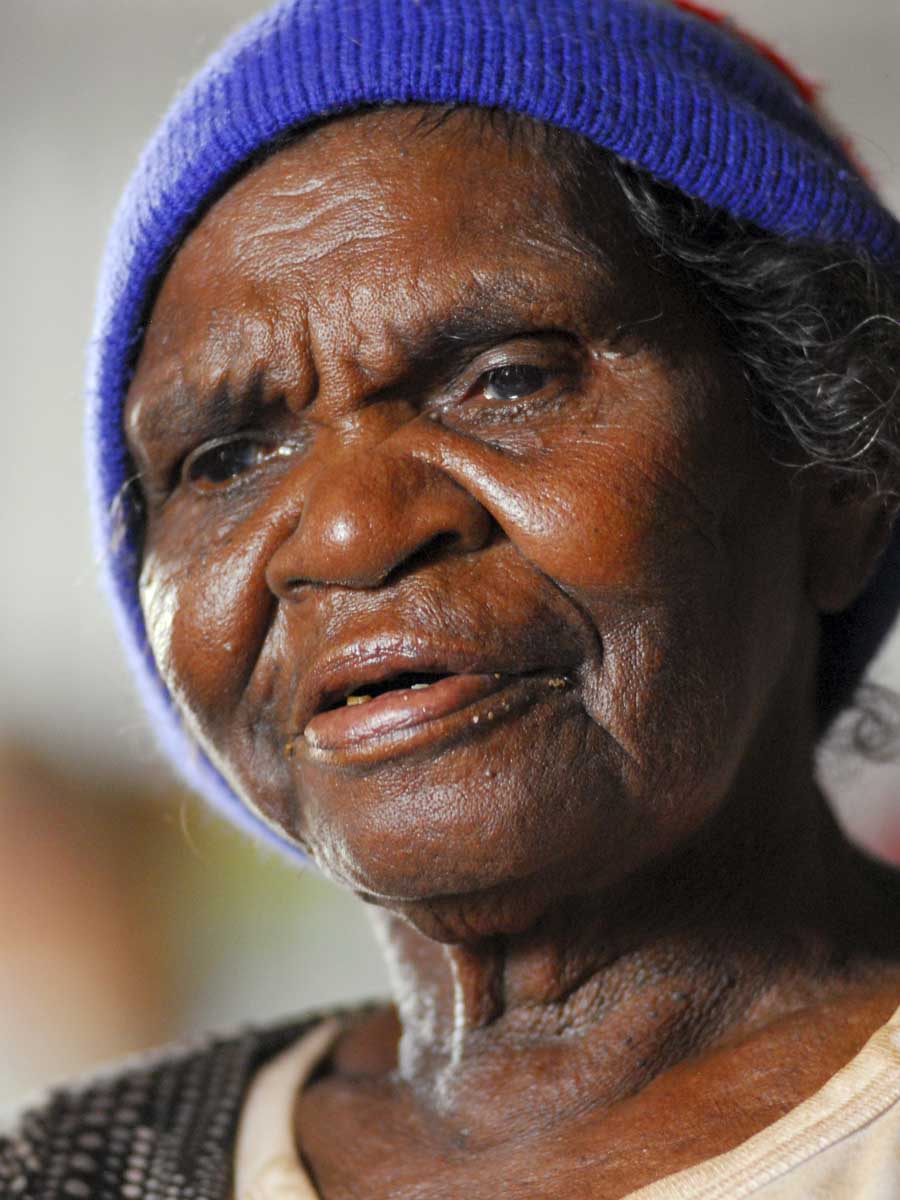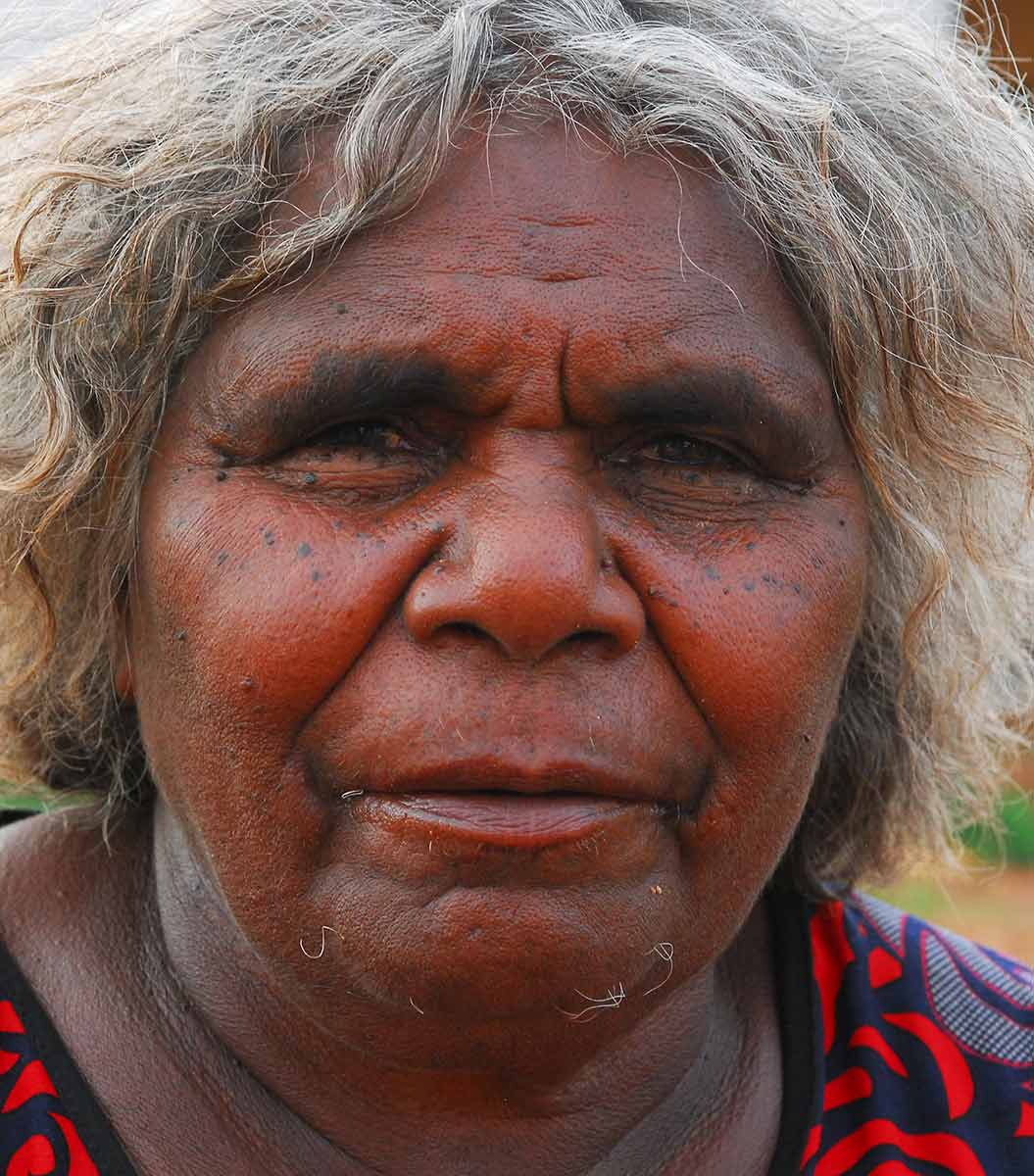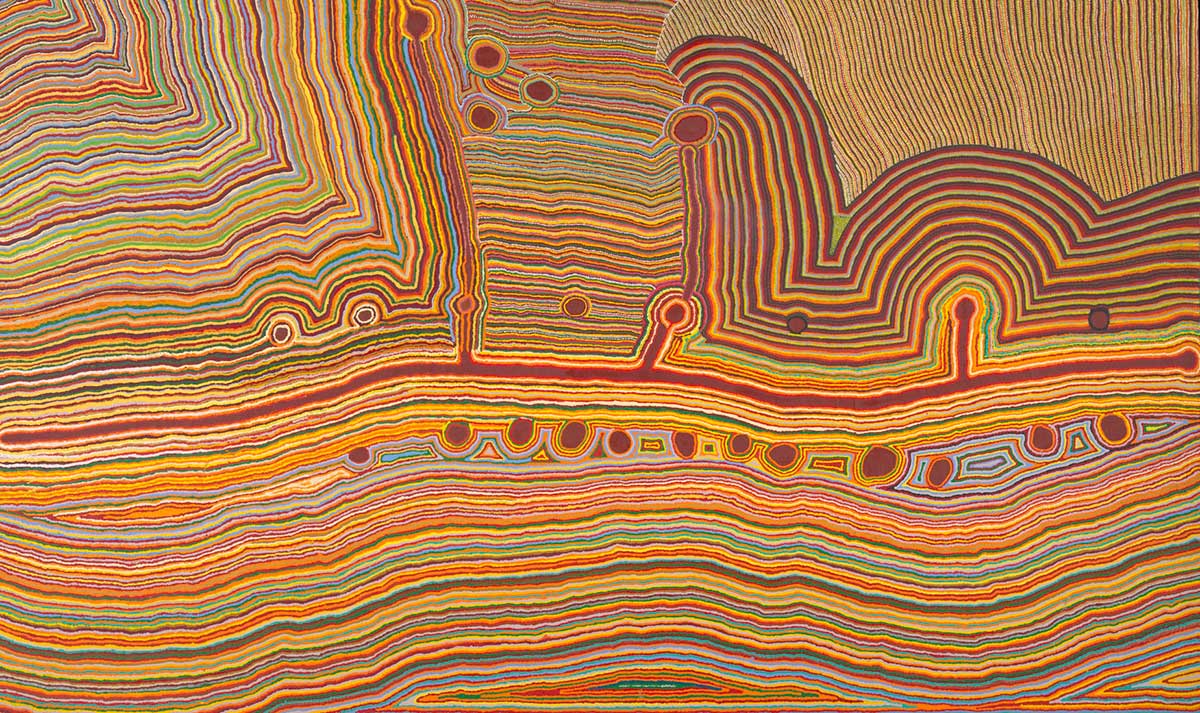
Six Martu women from central Western Australia created this painting, Martumili Ngurra, to tell the stories of their Country.
Measuring 3.2 x 5 metres, the canvas is one of the largest in the National Museum's extensive collection of Aboriginal art.
Martumili Ngurra (This is all Martu's Home) was painted in 2009 by Kumpaya Girgaba, J. Biljabu (dec.), Ngamaru Bidu, Thelma Judson, Ngalangka (Nola) Taylor and Jane Girgaba.
Martu peoples have the management and care of this landscape, which encompasses sections of the Little Sandy, Great Sandy and Gibson deserts, and is imbued with the journeys of ancestral beings.
For countless generations, Martu peoples have fulfilled their responsibility through seasonal burning and, more recently, by painting their Country on canvas.
The Museum bought Martumili Ngurra in 2009 as part of the Yiwarra Kuju: The Canning Stock Route project – a joint creative initiative between the National Museum of Australia and FORM.
The project, which explored the history and current art practices of Aboriginal communities along the route, resulted in the acquisition of the Canning Stock Route collection and a major touring exhibition.
The story behind the painting Martumili Ngurra, featuring artists J. Biljabu (dec.), Ngamaru Bidu, Thelma Judson and Ngalangka (Nola) Taylor. Read the transcript
Dreaming tracks
Represented in Martumili Ngurra are the tracks of numerous Jukurrpa (Dreaming) and community journeys, as well as important geographical sites and roadways related to the mining and pastoral industries that arrived in the region during the 19th century.
The Talawana Track, which intersects the Canning Stock Route, runs across the centre of the painting, with pathways to communities and water wells.
Sites from one of the Martu women’s most important Dreamings, the Minyipuru (Seven Sisters), are shown in smaller circles, along with paths used for hunting and maintaining the landscape. The repetitive multicoloured lines represent sandhills at various stages of regeneration following fire treatment, or ‘burning the Country’, and the waterholes, soakwaters and springs of the area.
Martu peoples were left or were forced into missions away from their homelands after the completion of the Canning Stock Route in 1910, and later, for the construction of the Talawana Track, built to service the Woomera missile testing project in the early 1960s. Many Martu peoples returned to their country in the 1980s.
Creating and selling artworks helps the Martu maintain economic independence and strengthen their communities. The Martumili Ngurra artists are associated with the Martumili Artists art centre and the community of Parnngurr.
Martumili Artists
Martumili Artists represents artists from six Martu communities in the Pilbara in Western Australia: Kunawarritji, Punmu, Nullagine, Parnpajinya/Newman, Jigalong and Parnngurr. Martu lands cover a large stretch of Country, from south of Well 5 to Well 39 on the Canning Stock Route.
Martumili Artists has grown rapidly, establishing a national reputation for innovative and dynamic art practice, since starting up in late 2006. Martumili has staged exhibitions throughout Australia and is attracting a growing international audience.
Martumili focuses on collective arts projects that have strong links to Country and culture, often resulting in the production of large collaborative paintings.
The Martumili Arists profiled below created Martumili Ngurra.

Kumpaya Girgaba
born about 1945, Manyjilyjarra language group, Karimarra skin group, Parnngurr community, Martumili Artists
A respected law woman and cultural leader, Kumpaya was born near Kiwirrkurra and grew up around the Canning Stock Route.
For many years her family avoided contact with Europeans, but eventually they moved to Jigalong mission to join their relatives.
Kumpaya learned how to paint and weave baskets while visiting family in Balgo, Fitzroy Crossing and Patjarr. She is credited with introducing these skills to Martu people.

J. Biljabu
about 1937 to 2022, Manyjilyjarra language group, Purungu skin group, Punmu community, Martumili Artists
J. Biljabu was born near Pitu, east of Well 25, and grew up around Kunawarritji, Rarrki and Nyilangkurr, where her father died.
In 1963, with her husband and extended family, she met the surveyor Len Beadell, who was grading roads for the Woomera rocket range. This meeting prompted them to join their relatives who were living at Jigalong mission.
In 1982 J. Biljabu moved to Punmu community, where she lived with her children and grandchildren.

Ngamaru Bidu
born about 1950, Manyjilyjarra language group, Karimarra skin group, Parnngurr community, Martumili Artists
Ngamayu grew up around Pitu. As a child, she encountered surveyor Len Beadell, who was grading roads near Well 22. He gave Ngamayu and her siblings fruit. Not realising that it was meant to be eaten raw, they cooked the fruit until it was completely dried up.
After meeting Beadell, Ngamayu's family was picked up at Parnngurr rock hole and taken to Jigalong.

Thelma Judson
born about 1956, Manyjilyjarra language group, Milangka skin group, Parnngurr community, Martumili Artists
Thelma was born in the Percival Lakes region and grew up around Yimiri and Kurturarra. In 1964 her family was one of the last Martu groups to leave the desert and be reunited with their families at Jigalong mission.
After she left school, Thelma moved to Strelley station and married in Jigalong, where she had her children. Today she lives in Parnngurr with her husband, Yanjimi Peter Rowlands, and their children.

Ngalangka (Nola) Taylor
born 1956, Manyjilyjarra language group, Karimarra skin group, Parnngurr community, Martumili Artists
Nola works closely with Martumili Artists as a translator and adviser for Martu people. In 2007 she joined the 'return to Country' trip at Well 36.
She translated the majority of the Martu oral histories for the Canning Stock Route project.
As a cultural mentor under the leadership of Martu elder, Kumpaya Girgaba, she has also provided guidance and support to curator Hayley Atkins, filmmaker Morika Biljabu and the whole project team. She has helped facilitate many trips in Martu Country.

Jane Girgaba
born early 1960s, Manyiljarra language group, Milangka skin group, Parnngurr and Newman, Martumili Artists
Jane was the daughter of Kumpaya Girgaba and Nyarri Morgan, both senior Martu elders and artists who live at Parnngurr.
She started painting under the tutelage of her mother, Kumpaya. Painting the Martumili Ngurra canvas was the first time Jane worked collaboratively with senior Martu women.
The artist Jane Girgaba is now deceased. The artist’s family is happy for her image to remain on this website.
In our collection
